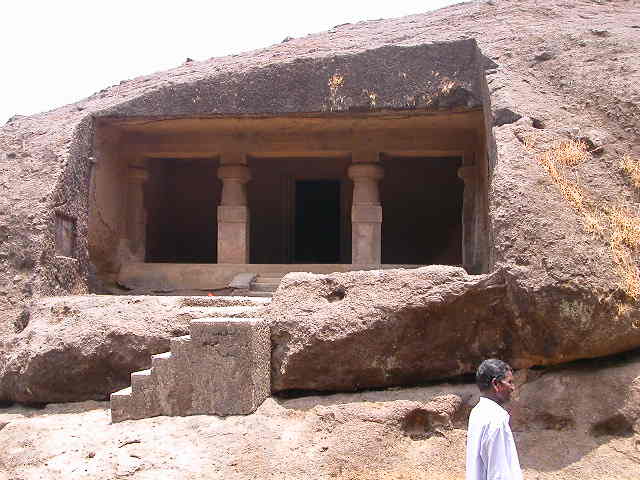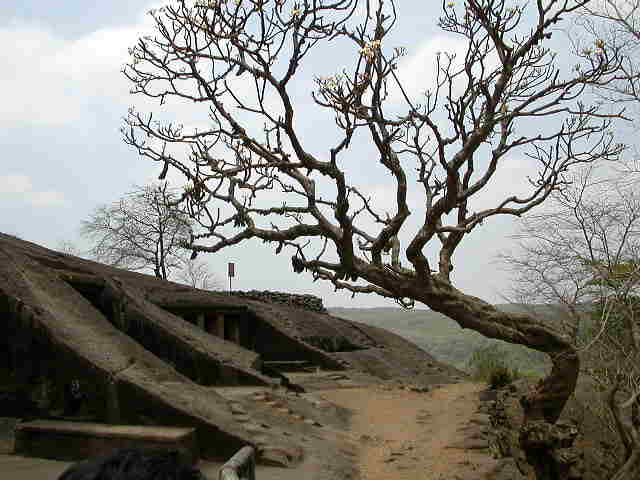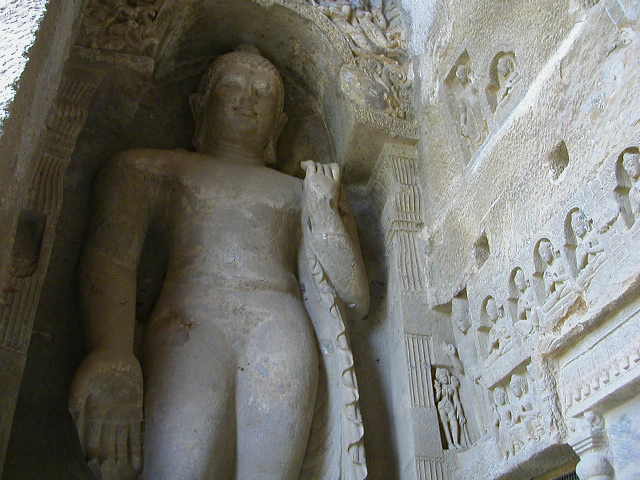 but the 109 Kanheri Caves do possess their own somber, spartan charms, and provide an intriguing insight into the Buddhist history of west India. I must admit I didn't visit the Caves by choice, but was rather hauled out here by my thuggish guide and his driver, who had abducted me on my first disoriented morning in Mumbai, and refused to let me go. The pair had latched on to me literally the moment I bundled out of my taxi at the Gateway of India, blinking in the sunlight and looking like a full sucker; for the past 24 hours they had been leeching me for all that I was worth, US$100 a pop plus tips, and my travel funds were dwindling at a dangerous rate. I would have been happy just hanging out in Colaba and eating some wicked cheap food, browsing for obscure books, or maybe catching a ride on a suburban train... these sharks had other ideas. They had whisked me off on a city tour, found me a hotel to stay in, and even threatened to plan a itinerary for my entire Indian vacation, all in the first couple of hours of my arrival in Mumbai. For some reason I didn't think they were quite serious about the itinerary, and as I bid my adieus and checked into my hotel, I kind of expected they would just forget about me, and move on to the next victim. How foolish and naive was I? how little did I understand how the Indian hard sell worked? They weren't going to let me go that easily! When I stepped outside my lodgings the following day, just up the road from the Taj Hotel, I was alarmed to see them lurking at the gate, paparazzi-style, their tour car parked beneath a tree. "We've been waiting here all morning," the guide said, a grimace distorting his face. "You get up late." He went on to insinuate that they would be really offended if I didn't take another of their ridiculously overpriced tours, to complement the rip-off tour I had taken with them the previous day. This should have been a lesson that politeness gets you nowhere in India, especially when dealing with touts; this should have been my cue to toughen up and act more assertive. I should have raised my voice with them, told them to piss off, and stormed off into the maelstrom, melting into the crowds like Johnny Depp escaping the paps. I have lived in Japan for the past five years, however, and life in Japan has made me soft. I am just too damned polite these days. Biting my tongue Japanese tourist style, internalizing my rage, I acquiesced to their demands, and let them take me out to the Kanheri Caves, the destination of the day. The Caves lay beyond one of Asia's largest slums, in the depths of Sanjay Gandhi National Park. Driving through the dry woods of the national park, hounded and surrounded by monkeys and scavenging children, I fretted about how I was going to escape the clutches of the malevolent duo I had fallen in with. Could I give them the slip at the next toilet stop? I wondered, but then realized that wouldn't work... they knew what hotel I was staying at. To take my mind off things, I focused on the scenery passing outside. It was actually quite beautiful in a wild Indian way, and I started to feel like I was Bungalow Bill without his Mum, off on an expedition through the jungle. The feeling perked me up; I would have totally missed this if I had spent the whole day in the city! I'll finish this tour, then, I thought to myself, but tomorrow I am ditching these bloodsuckers for good! Even if it meant finding a new hotel. We passed the edge of a Lion safari park not far from the Caves, and then drove straight through a Jain community full of smiling, waving children. My guides, I noticed, were Muslims, and there was a gold-plated reading from the Qur'an hanging from the rear-vision mirror. I wondered what Islam would say about hustling poor tourists like myself... I mean, wasn't it kind of haram? I'd heard it said that cheating wealth made you a sinner in Islam, and was going to say something along those lines, but then decided now was not the right time. I was stuck in a car with two thugs in the middle of a tiger jungle, on the edge of a lion safari park. I was totally at their mercy. For the second time today I bit my tongue, and internalized my rage. But at least the scenery was nice.
but the 109 Kanheri Caves do possess their own somber, spartan charms, and provide an intriguing insight into the Buddhist history of west India. I must admit I didn't visit the Caves by choice, but was rather hauled out here by my thuggish guide and his driver, who had abducted me on my first disoriented morning in Mumbai, and refused to let me go. The pair had latched on to me literally the moment I bundled out of my taxi at the Gateway of India, blinking in the sunlight and looking like a full sucker; for the past 24 hours they had been leeching me for all that I was worth, US$100 a pop plus tips, and my travel funds were dwindling at a dangerous rate. I would have been happy just hanging out in Colaba and eating some wicked cheap food, browsing for obscure books, or maybe catching a ride on a suburban train... these sharks had other ideas. They had whisked me off on a city tour, found me a hotel to stay in, and even threatened to plan a itinerary for my entire Indian vacation, all in the first couple of hours of my arrival in Mumbai. For some reason I didn't think they were quite serious about the itinerary, and as I bid my adieus and checked into my hotel, I kind of expected they would just forget about me, and move on to the next victim. How foolish and naive was I? how little did I understand how the Indian hard sell worked? They weren't going to let me go that easily! When I stepped outside my lodgings the following day, just up the road from the Taj Hotel, I was alarmed to see them lurking at the gate, paparazzi-style, their tour car parked beneath a tree. "We've been waiting here all morning," the guide said, a grimace distorting his face. "You get up late." He went on to insinuate that they would be really offended if I didn't take another of their ridiculously overpriced tours, to complement the rip-off tour I had taken with them the previous day. This should have been a lesson that politeness gets you nowhere in India, especially when dealing with touts; this should have been my cue to toughen up and act more assertive. I should have raised my voice with them, told them to piss off, and stormed off into the maelstrom, melting into the crowds like Johnny Depp escaping the paps. I have lived in Japan for the past five years, however, and life in Japan has made me soft. I am just too damned polite these days. Biting my tongue Japanese tourist style, internalizing my rage, I acquiesced to their demands, and let them take me out to the Kanheri Caves, the destination of the day. The Caves lay beyond one of Asia's largest slums, in the depths of Sanjay Gandhi National Park. Driving through the dry woods of the national park, hounded and surrounded by monkeys and scavenging children, I fretted about how I was going to escape the clutches of the malevolent duo I had fallen in with. Could I give them the slip at the next toilet stop? I wondered, but then realized that wouldn't work... they knew what hotel I was staying at. To take my mind off things, I focused on the scenery passing outside. It was actually quite beautiful in a wild Indian way, and I started to feel like I was Bungalow Bill without his Mum, off on an expedition through the jungle. The feeling perked me up; I would have totally missed this if I had spent the whole day in the city! I'll finish this tour, then, I thought to myself, but tomorrow I am ditching these bloodsuckers for good! Even if it meant finding a new hotel. We passed the edge of a Lion safari park not far from the Caves, and then drove straight through a Jain community full of smiling, waving children. My guides, I noticed, were Muslims, and there was a gold-plated reading from the Qur'an hanging from the rear-vision mirror. I wondered what Islam would say about hustling poor tourists like myself... I mean, wasn't it kind of haram? I'd heard it said that cheating wealth made you a sinner in Islam, and was going to say something along those lines, but then decided now was not the right time. I was stuck in a car with two thugs in the middle of a tiger jungle, on the edge of a lion safari park. I was totally at their mercy. For the second time today I bit my tongue, and internalized my rage. But at least the scenery was nice. That sounded cool, but what was even more surprising was the realization that this vast Hindu realm was once almost entirely Buddhist... for a fleeting moment of time, at least. When Ashoka the Great Unifier ruled India, back in the 3rd century before Christ, Buddhist doctrine was exported as far afield as Greece. In his efforts to propagate Buddhism, Ashoka built shrines and monasteries all over India... my Soka Gakkai friends in Japan would call him a legend! He inscribed Buddhist teachings on rocks and pillars in many places. At Kanheri these engravings can be seen, written in the ancient Brahmi script, as well as Devanagari and Pahlavi. The empire ebbed, as all empires do, and all that were left behind were the deep-sea fishermen called Kolis, whose stone goddess Mumbadevi gave her name to the modern metropolis of Mumbai... and the ruins at Kanheri.
That sounded cool, but what was even more surprising was the realization that this vast Hindu realm was once almost entirely Buddhist... for a fleeting moment of time, at least. When Ashoka the Great Unifier ruled India, back in the 3rd century before Christ, Buddhist doctrine was exported as far afield as Greece. In his efforts to propagate Buddhism, Ashoka built shrines and monasteries all over India... my Soka Gakkai friends in Japan would call him a legend! He inscribed Buddhist teachings on rocks and pillars in many places. At Kanheri these engravings can be seen, written in the ancient Brahmi script, as well as Devanagari and Pahlavi. The empire ebbed, as all empires do, and all that were left behind were the deep-sea fishermen called Kolis, whose stone goddess Mumbadevi gave her name to the modern metropolis of Mumbai... and the ruins at Kanheri.According to the Mahaarashtran Tourist Information Site:
 "The viharas at Kanheri indicate a large monastic settlement which probably began in the 1st century AD when the bhikshus followed the austere Hinayana tradition. The settlement grew into a scholastic centre with a large library and continued through generations of monks for several centuries. The cells are provided with stone beds and cisterns for storing water, and are connected by walkways.
"The viharas at Kanheri indicate a large monastic settlement which probably began in the 1st century AD when the bhikshus followed the austere Hinayana tradition. The settlement grew into a scholastic centre with a large library and continued through generations of monks for several centuries. The cells are provided with stone beds and cisterns for storing water, and are connected by walkways."Over time, the bhikshus enlarged their rock-cut Caves and in each group of viharas one was set aside as a chapel for meditation and the performance of prayer rituals. A stupa, now a votive memorial, was carved at the inner end and the arrangement of columns allowed a circumambulatory passage around it. Over the entrance was the characteristic arch in the shape of a pipal leaf. Originally simple and even severe, as at Bhaja, the chaitya developed into an impressive shrine like the magnificent Karla chaitya of the 2nd century AD -- an inscription here claims that it is the finest in ancient India..."

No comments:
Post a Comment